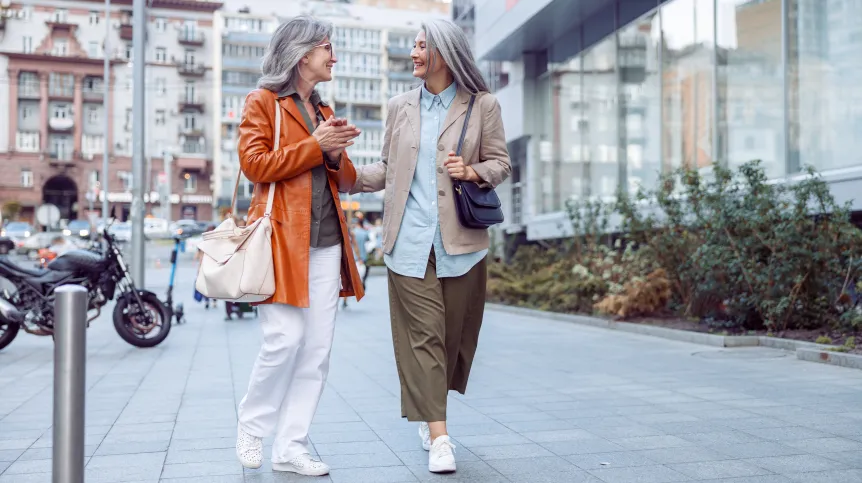
Benches with armrests, characteristic points in space, outdoor gyms. By designing for seniors, we create great solutions for the entire society, says architect Dr. Anna Miśniakiewicz from the Wrocław University of Science and Technology.
Demographic forecasts of the Central Statistical Office show that a constant increase in the number of people over 65 years of age is expected in Poland until 2060. By then people of this age will constitute over 38% of the general population. At that point, there will be 11.9 million seniors, i.e. 21%. more than in 2022.
Meanwhile, in the Active Ageing ranking prepared by the United Nations Economic Commission for Europe - indicating the possibilities of active and healthy ageing - Poland is one of the last among the 28 European Union countries. In the last, 2018 edition of the ranking, Poland had 30.9 points out of 100 and took 24th place, ahead of only Hungary, Romania, Croatia and Greece.
'The Western Europe societies are already societies of advanced age. The countries of that region have managed to prepare for the ageing population in terms of infrastructure. There, the age transformation occurred earlier than here', says Dr. Miśniakiewicz.
The expert specialises in the sustainable development of modern cities, pro-social architecture, user-oriented design and design in harmony with nature. She focuses especially on the issue of ageing society.
She says that when designing architectural solutions for older people, one can draw inspirations from what has already been developed in other countries, but also use general guidelines prepared, for example, by WHO.
Bench for seniors
The radius of movement of people over 80 years of age - she emphasizes - often reaches only 500 meters around the house. Therefore, sometimes very simple and basic solutions favouring people of advanced age are important: appropriate benches, shaded resting places, toilets available in shop areas and pedestrian crossings convenient for seniors.
'For older people, we should place benches at a distance of a hundred meters from each other, because walking several hundred meters can be a huge problem for them. Even if we do not have enough space for a regular seat bench, the solution may support benches, i.e. benches that are much higher but narrower, on which one can lean. They allow people to quickly get some rest. We also minimize the need to sit down and get up, which is a very high energy effort for older people. A good temporary solution is to place a chair in front of a shop', Miśniakiewicz says.
Support benches can also be placed at pedestrian crossings so that one can lean on them while waiting for the green light.
In newly designed public spaces, designer benches are very often placed that lack armrests and comfortable backrests. 'Without them, an elderly person who no longer has full control over their body may lose their balance when sitting down and fall backwards. Armrests, in turn, help when getting up. These are sometimes very simple and basic solutions, but we do not talk enough about them, says Miśniakiewicz.
Very often, seniors have trouble crossing a pedestrian crossing, even one with traffic lights. 'Sometimes the green light is so short that even a young person has to hurry to cross, and what should an elderly person do? An interesting solution, although this is an example of a smart city, is used in Singapore. Older people have contactless senior cards. When approaching a pedestrian crossing, they use the card to extend their crossing time', Miśniakiewicz continues.
In view of the warming climate and increasingly higher temperatures, especially in cities, it is also necessary to maintain a large amount of natural greenery, trees and shrubs.
'This is also necessary in the context of the movement of older people. If there are no trees in a given place where seniors move, shading should be provided in another way, e.g. with pergolas, benches placed in the shade, or with some kind of roof. Green areas are conducive to everyday activities, which are crucial for ensuring physical and mental health. Pocket parks and community gardens are also a great solution. In the West, drinking water fountains are also standard in urban spaces and extremely useful during hot weather', Miśniakiewicz says.
In her opinion, in order to be not only a place for rest, but also a social space, benches should be arranged in a slightly different way than they are now. In Poland, they are usually placed along the sidewalk or alley, and it is better to arrange them in a semicircle or opposite each other. This arrangement gives people the opportunity to talk to others, meet and have the so-called social space.
Gym is better than senior club
In Poland, many people become prisoners in their apartments, for example on the fourth floor of a tenement house without an elevator. Miśniakiewicz believes these are big infrastructure problems, because in the process of taking care of seniors, it is necessary to create pro-social spaces where they can meet, be in a public space and socialise instead of staying in the confines of their own apartment.
'But where would older people go? To a cafe where, for example, a cup of coffee costs PLN 20 and they would have to face a high expense, considering the size of the wallet of most Polish retirees? This is not Italy or Spain, where you can sit down for a cup of coffee that costs 1 euro,” she says adding that outdoor gyms are a relatively good solution that has become popular in Poland.
However, it is much more common to assume that senior clubs are meeting places for older people.
'Firstly, it is stigmatising, and secondly, it actually cuts off seniors from the rest of society. Of course, people feel best among their peers and all types of services should be provided to seniors, but it is best to focus on multi-generational, diversified spaces or facilities, e.g. with a place for children, teenagers and young families. Such as clubs and cafes that build communities', Miśniakiewicz says.
She points out that in Poland there is a large and unfavourable division in the housing structure. Young people, young families, but few elderly people live in development estates. If children grow up in such housing estates, they almost never see or interact with older people, which in turn leads to greater isolation of seniors.
In turn, in older housing estates and tenement houses, mainly older people live, and few young people.
'This is why we should start to talk about a different approach to designing facilities. So that they are not facilities for seniors, but simply mixed ones, i.e. age-differentiated, housing estates in a social mix. If we are designing a care centre, let it have some additional function combined with these younger users, young people with children, such as intergenerational homes', says Miśniakiewicz.
Such places - as she points out - should be financed from local budgets because they support the idea of active ageing, which assumes that seniors should feel that they are part of society. 'Lifestyle determines longevity. People who are active physically, socially and mentally are healthier. They are less of a burden on health services', she says.
Tame the urban jungle
Dr. Miśniakiewicz was the coordinator of the Popowice Laboratory project, in which experts, together with seniors, checked what solutions older people liked and what bothered them in the urban space in Popowice in Wrocław.
Popowice is a housing estate from the 1970s that has a large amount of green areas, numerous services, large spaces between buildings. According to Miśniakiewicz such a housing estate is a good place for older people.
'I did not think that the residents could be bothered by the lack of aesthetic purity of the estate, and they, for example, had a huge problem with graffiti on the walls and simply spoiling them. Another issue was that there was too much information, advertising columns, papers, leaflets and it was extremely overwhelming for them. But removing graffiti, for example, is a quick and simple matter', she says.
This confirms that when designing for older people, it is important to refer to the basics of design principles: legible, clear, logical and intuitive information is important.
'Meanwhile, you can see how housing estates are designed nowadays. These are often identical buildings, we do not really know where we are in this housing estate. Elderly people need characteristic places that will make it easier to navigate the area, recognize where they are and intuitively locate themselves. These may be some elements of art, sculptures, buildings with a specific colour', she says.
'It is worth remembering that when we create something with seniors or people with disabilities, we very often, almost always even, create a great solution for the entire society. It is not that something created for these particular groups is only for them, is usually a very good solution for everyone. Because it is super comfortable', she adds. (PAP)
PAP - Science in Poland, Ewelina Krajczyńska-Wujec
ekr/ zan/ kap/
tr. RL













